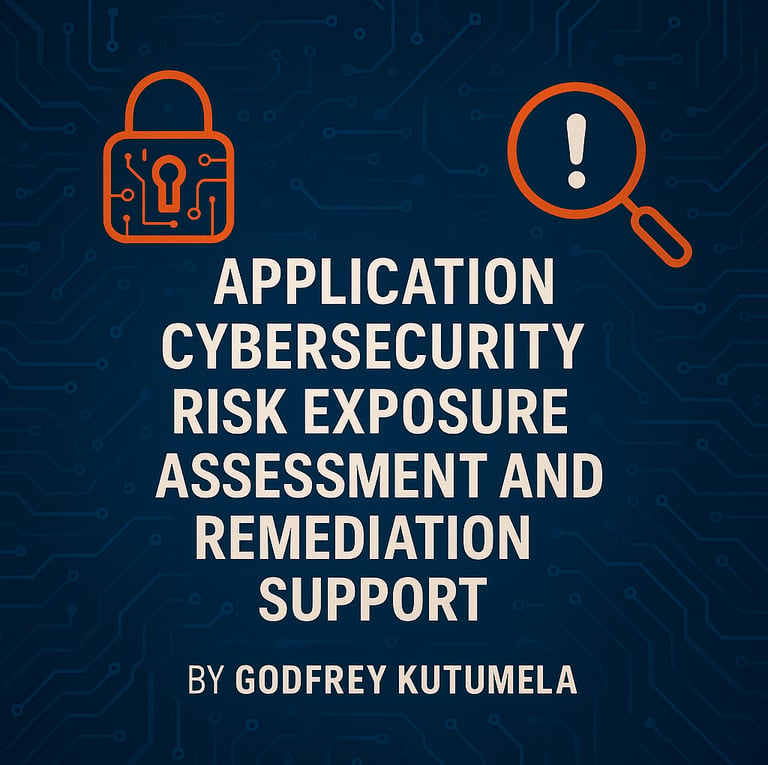Nucleus Systems Application Cybersecurity Risk Exposure Assessment and Remediation Support
How secure are your fast payment systems? In response to the World Bank’s latest report, Nucleus Systems introduces a tailored cybersecurity service to assess and remediate risks across the full application lifecycle—because speed without security is a risk no nation can afford.
Godfrey Kutumela
4/18/20253 min read


Service Overview
To strengthen the security posture of the application, Nucleus Systems has created a comprehensive cybersecurity exposure assessment that consists of a mix of Whitebox and Blackbox security techniques, focusing on prevention, detection, and remediation of potential vulnerabilities. The effort aligns with industry best practices such as OWASP, SANS/CWE, and CIS benchmarks.
1. Security Architecture Design Review
This service provides a structured, high-level assessment of the application’s system architecture to identify potential security vulnerabilities early in the design phase. It focuses on critical areas such as identity and access management, authentication, key management, and the CI/CD pipeline. By aligning with zero-trust principles and industry standards like OWASP and SANS, this review ensures that foundational security is integrated into the platform to prevent downstream risks and support long-term scalability.
Why is it important?
Early design flaws are often the most expensive to fix post-deployment. This service ensures security is built into the foundational design—covering Identity & Access Management (authentication and authorisation), key management, data security, logging and auditing.
How it is delivered:
A tabletop-based architectural review with Application architects.
Evaluates platform identity and access controls, zero-trust principles, and secure service-to-service communication.
Reviews the CI/CD process, including infrastructure-as-code (IaC), Helm charts, and pipeline security.
Identifies misalignments with standards and provides remediation strategies.
What is the deliverable?
A Secure Design Key Findings Report with prioritized risk assessments and practical improvements to enhance resilience and scalability.
2. Source Code Risk Assessment
A comprehensive static code analysis service aimed at uncovering vulnerabilities, insecure coding practices, and third-party risks in both custom and open-source components. It evaluates the code against established security benchmarks such as OWASP Top 10 and CWE Top 25, scans for hardcoded secrets, outdated dependencies, and open-source license violations, ultimately helping to reduce technical debt and improve overall code quality and compliance.
Why is it important?
Vulnerabilities in code—especially those introduced during development or via third-party libraries—can be exploited, leading to data breaches or system compromise.
How it is delivered:
Performs static analysis (Whitebox) using automated tools (SAST, SCA) to scan for vulnerabilities in custom and open-source code.
Assesses code quality, input validation, credential handling, and dependency risks.
Checks for software license requirements (open source and private licenses) and secrets exposure.
What is the deliverable?
A Code Scanning Report highlighting specific vulnerabilities (e.g., OWASP Top 10), including suggested fixes and strategic guidance to improve secure coding practices.
3. Software Build and Release Configuration Security Checks
This service audits security in software release practices, the CI/CD pipeline, container configurations, and infrastructure-as-code templates, to ensure secure software delivery practices are in place. It focuses on preventing credential leakage, validating container security against CIS benchmarks, and identifying misconfigurations that could compromise build integrity or production readiness, helping to enforce strong release hygiene and minimize supply chain risks.
Why is it important?
The software delivery pipeline is a growing attack vector. Misconfigurations or exposed secrets in build tools can undermine an otherwise secure application.
How it is delivered:
Analyzes CI/CD pipelines and container configurations to identify weak points in the build and deployment process.
Scans for hardcoded credentials, misconfigured runtime environments, and insecure artifacts.
Leverages CIS benchmarks and secure secrets management evaluations.
What is the deliverable?
A Configuration Security Report that uncovers exposure points in the software lifecycle and delivers targeted recommendations to secure build environments and release process.
4. Production Runtime Environment Security Testing
A Blackbox testing service that simulates real-world attacks on the live environment using dynamic application security testing (DAST) and targeted penetration testing techniques. It assesses vulnerabilities in APIs, web interfaces, cloud infrastructure, and runtime behaviors, revealing exploitable security gaps under operational conditions and ensuring the platform is resilient against external threats and insider risks.
Why is it important?
Security controls must be validated in real-world settings. Live systems may exhibit flaws that are not visible in static reviews.
How it is delivered:
Conducts dynamic application security testing (DAST) to identify runtime issues like SQL injection, XSS, and broken access controls.
Executes penetration testing on APIs, web interfaces (authenticated and unauthenticated), and the hosting environment network and infrastructure (aka - attack surface).
Simulates attacker behavior to assess how the system responds to real-world threats.
What is the deliverable?
A penetration testing and vulnerability report provides a detailed view of exploitable risks and how to address them effectively in production.
5. Remediation Support
Application security vulnerability remediation support is essential to improving an application's overall security risk posture because identifying vulnerabilities alone does not reduce risk—fixing them does. Remediation support ensures that security issues discovered during assessments, code scans, and penetration testing are properly understood, prioritized, and effectively resolved. It bridges the gap between detection and action, helping development teams apply best practices, avoid recurring mistakes, and ensure long-term resilience.
Why is it important?
Without dedicated remediation efforts, vulnerabilities may remain unpatched due to knowledge gaps, resource constraints, or misaligned priorities, exposing the application.
How it is delivered:
Nucleus Systems offers XX hours of bundled expert support to provide detailed remediation technical guidance and ensure best practices are adopted over a 3–6-month period.
Ongoing support from experienced security professionals also helps embed secure coding habits, streamline incident response, and build a proactive security culture across the development lifecycle.
What is the deliverable?
Remediated application vulnerabilities and reduced application security risk exposure.
